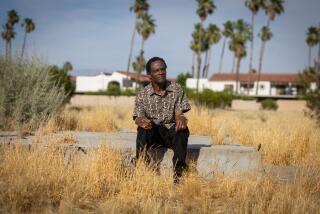State May Take Part of Development Site : Hughes Estate Would Give Up 70 Acres at Playa Vista to Pay Tax Debt
- Share via
The state may take a significant portion of the massive Playa Vista development site as payment for estate taxes owed by heirs of billionaire Howard Hughes.
A September, 1984, agreement between 22 Hughes heirs and the California controller’s office gives state Controller Gray Davis until the end of February to decide whether the state will accept control of almost 70 acres in the northeastern portion of the development site or take $75 million. If the state accepts the land the Hughes heirs must fund $11 million in road and drainage improvements in the area as part of the agreement.
“The heirs would be inclined as a group to keep the cash, but it is not our call,” said William Miller, a lawyer for the Hughes estate.
The Summa Corp., which is owned by the Hughes heirs, plans to build 2,400 hotel rooms, 8,837 residential units, 5.9 million square feet of office space, 970,000 square feet of retail space and a 40-acre marina on the 957-acre Playa Vista site. Almost 210 acres will be set aside as a wetland wildlife preserve.
But critics, including Councilwoman Ruth Galanter, said the scale of the proposed development must be reduced and the wetland preserve should be increased to about 325 acres. Most of Playa Vista is within Galanter’s district.
Summa’s plans call for the 70-acre northeastern portion to absorb more than a million square feet of office and retail space and about 2,000 residential units. If the state took that parcel as payment for the estate taxes, the development planned for the area might be reduced, said Jim Tucker, chief deputy state controller.
“Nothing has been ruled out as long as it is consistent with the concerns about overdevelopment in Los Angeles,” he said.
Davis may take the land to “ensure that the property is dealt with in the most responsible way possible,” Tucker said. “Or he may conclude that the most benefit to the state would be to take the cash now.”
The controller’s office and the Hughes estate have discussed a third option in which the state would take ownership of the environmentally sensitive southwestern section of Playa Vista, known as Parcel B, and an undetermined amount of cash to settle the tax debt.
At 336 acres, Parcel B is considerably larger than the northeastern portion but is worth less because it’s not as commercially desirable. It contains the area that Summa has set aside for a wetland preserve for wildlife. Summa’s plan to build more than 2,300 residential units on the remainder of the parcel is being opposed by an environmentalist group, which has filed a lawsuit.
“I’ve been trying to get both the state and the Playa Vista people to work out an arrangement that would result in the state taking Parcel B,” Galanter said.
“I’d obviously prefer to have the area with the wetlands protected from development and that would be easier if it belonged to the state,” she said.
But negotiations over Parcel B have stalled over how much money the estate should pay and Miller’s request that the City of Los Angeles guarantee it will approve Summa’s plans for the remainder of Playa Vista.
As far as the state is concerned “cash is the only problem in the Parcel B option,” Tucker said.
But Miller said he will not accept the plan without guarantees on development.
“They announced they wanted me to sign off on the amount of total development in the project,” Galanter said. “But I said I cannot sign off on that without much more discussion.”
Summa must get approvals from the city before it can proceed with its development plans.
“I am not about to agree to something without being careful to talk to the community and to think out the risks,” Galanter said. “One of the major unresolved issues is that the total amount of development is more than the area can handle.”
“The Playa Vista people have assured me repeatedly that they want to meet my concerns but have shown no willingness to reduce” the project, Galanter said.
The state will most likely choose between the 70-acre parcel or the $75 million, Miller said.
“I think the wetlands trade and Parcel B and all of that would be a nice thing to do but there are probably certain considerations that make it a very remote possibility,” Miller said.
“Developers need to know what they can develop and do with the property and that is the crux with any kind of trade that can be talked about,” he said.
If the state takes control of the 70-acre parcel, Summa will stick to its development plans for the remainder of the area, Miller said.
Davis will not make a decision for the state “till the last day or close to it,” Tucker said.
“It is hard to judge whether things can be resolved,” he said. “In negotiations a lot happens at the last moment. We have to get closer to the last moment before we can see what is likely.”
Galanter and representatives of area neighborhood groups have said the state should accept land rather than cash to reduce the level of development in the Playa Vista area.
More to Read
Sign up for Essential California
The most important California stories and recommendations in your inbox every morning.
You may occasionally receive promotional content from the Los Angeles Times.













